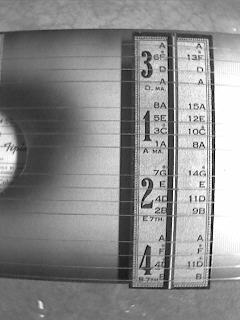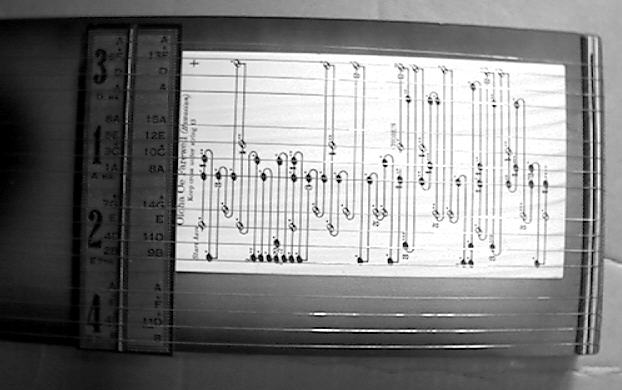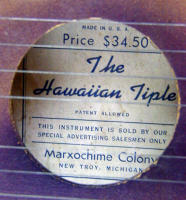

Introduction
The Hawaiian Tiple is an instrument with zither-like and lap steel-like qualities. It is played by plucking, strumming and using a slide. It was one of a number of novel, inexpensive instruments developed by Marxochime Colony during the first half of the twentieth century. See the Links section for pointers to more information about Marxochime Colony.
Note that the instrument commonly referred to as a Tiple is a Latin American instrument shaped like a small guitar with 8 to 12 strings arranged in four courses. Martin used to make a Tiple which was ukulele-sized with 8 or 10 strings. The Marxochime Hawaiians Tiple is not one of those.
Construction
The dimensions are 32-1/2" x 7" x 1-3/8". Material is an unknown hardwood. It has the density and color of spruce but it seems harder than spruce. Sides are 1" thick. Top and bottom are 3/16" thick. There is no bracing on the top and bottom but there are two solid supports 2-1/2" in length and 1"x1" in cross section. The supports are located 13-1/2" and 19-1/2" from the edge with the tuners. There is a soundhole 2-1/2" in diameter.
The instrument is painted brownish-gold with a dark purple "sunburst" finish. The strings range from about .010" to .015" in diameter.
Layout

|
The instrument has sixteen strings arranged in four groups of four strings. Each group of four strings is tuned to a chord. The top group of four strings are tuned to a D major chord (A D F# A, low to high). The other sets are tuned to an A (A C# E A), E7 (B E G# D) and B7 (B D# F# A). These are the IV, I, V7 and II7 chords in the key of A. The bridge is positioned 2/3 of the way across the top. The strings are played on both sides of the bridge. The segment to the right of the bridge is exactly 1/2 the length of the segment to the left so the notes are exactly an octave higher. Individual notes can be played. The instrument takes advantage of the fact that the I, IV and V chords contain all of the notes in a diatonic scale. Marking on the bridge indicate the notes in the A diatonic scale. They are numbered from 1 to 8. The right side of the bridge contains notes that are exactly one octave higher so the notes from the second octave are also indicated and are numbered from 8 to 15. Playing a scale is tricky because the notes are scattered among the different groups of strings. |
There is a strip of paper under the top group of strings that shows the fret positions. These are used when playing with a slide. The strings in this group have the same relative relationship as the four highest strings on a dobro or lap steel tuned to the standard Open G tuning. Thus anything that can be playing on the four highest strings on those instruments can be played on this instrument.
Playing

The instrument comes with song sheets. These are placed under the strings on the right side of the instrument. To play a tune one follows the path and plucks the indicated notes in the order shown. There are markings to indicate the duration of the note. When a chord is to be strummed there is a number from 1 to 4 indicating which of the numbered chords are to be played.
Plucking and strumming seems to be the primary way of playing the instrument. The song sheets say nothing about the use of a slide even though the instrument is clearly set up to be played lap steel-style.
When plucking or strumming the instrument you get a lot of sympathetic vibrations by the undamped strings. It gives it a chimey, celestial sound similar to that of a hammer dulcimer or autoharp. It is not a very loud instrument.
When played lap steel-style the sound is very "thin" - not very dynamic, not very harmonically rich and not much sustain. However, it's not necessarily an unpleasant sound. A ukulele sounds thin compared to a guitar but it still has its uses.
Links

visits since Sept 15, 2002
Updates:
04/04/2006 - Moved to new server. Added note about real Tiples.